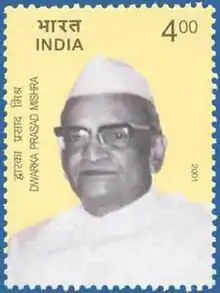Dwarka Prasad Mishra
Dwarka Prasad Mishra (5 August 1901 – 31 May 1988) was an Indian politician, writer and journalist. He was a member of the Indian National Congress and served as the Chief Minister of Madhya Pradesh for two terms during the 1960s.[2]
Dwarka Prasad Mishra | |
|---|---|
 | |
| 4th Chief Minister of Madhya Pradesh | |
| In office 30 September 1963 – 29 July 1967 | |
| Preceded by | Bhagwantrao Mandloi |
| Succeeded by | Govind Narayan Singh |
| Personal details | |
| Born | 5 August 1901 Padari, North-Western Provinces, British India (now in Uttar Pradesh, India) |
| Died | 31 May 1988 (aged 86)[1] |
| Relatives | Sudhir Mishra (grandson) |
| Occupation | Politician |
| Known for | Chief Minister of Madhya Pradesh |
An Indian freedom fighter and diplomat, he was from Padari a village in Unnao. As a poet he composed the mahakavya, Krishnayana (transl. Journey of Krishna). He became the Chief Minister of Madhya Pradesh after Ravi Shankar Shukla.[3]
Chief Minister
He served two terms as the chief minister of the state from 30 September 1963 to 8 March 1967 and 9 March 1967 to 29 July 1967. He, along with Chandra Bhanu Gupta (Chief Minister of Uttar Pradesh) were instrumental in getting the power sharing formula between Indira Gandhi and Morarji Desai post the 1967 election. It gave the Deputy Prime Minister post to Desai, but the agreement broke down in 1969 and the Congress subsequently split.
Writings
His writings include:
- Living an Era: India's March to Freedom (part one of memoirs, covering the period up to 1947)
- The Nehru Epoch: From Democracy to Monocracy (part two of memoirs, critiquing the time from 1947 to 1964)
- The Post Nehru Era: Political Memoirs (third and concluding part of memoirs, showing India in the post Nehru era up till the 1980s)
- The search for Lanka (famous for proposing the thesis that Ramayana's Lanka was in Madhya Pradesh instead of Sri Lanka)
His memoirs became controversial as they included a letter from Vallabhbhai Patel to Mishra dated to July 1946 criticising Nehru for "Juvenile Mistakes". Congress members questioned authenticity of the letter as well as Mishra's motives and timing of revelation.
He was also active in the struggle for Indian independence and went to jail for the cause, for the first time aged 19 in 1920.
References
- https://mobile.twitter.com/MIB_India/status/1663857925331517441
- "Dwarka prasad Mishra | कलम के पुजारी : पं. द्वारका प्रसाद मिश्र". Hindi.webdunia.com. Retrieved 11 July 2012.
- Personalities. unnao.nic.in.
External links
- DKPA : Stamp Calendar - Stamps Issued by India in August 2001 at the Wayback Machine (archived 27 October 2009)